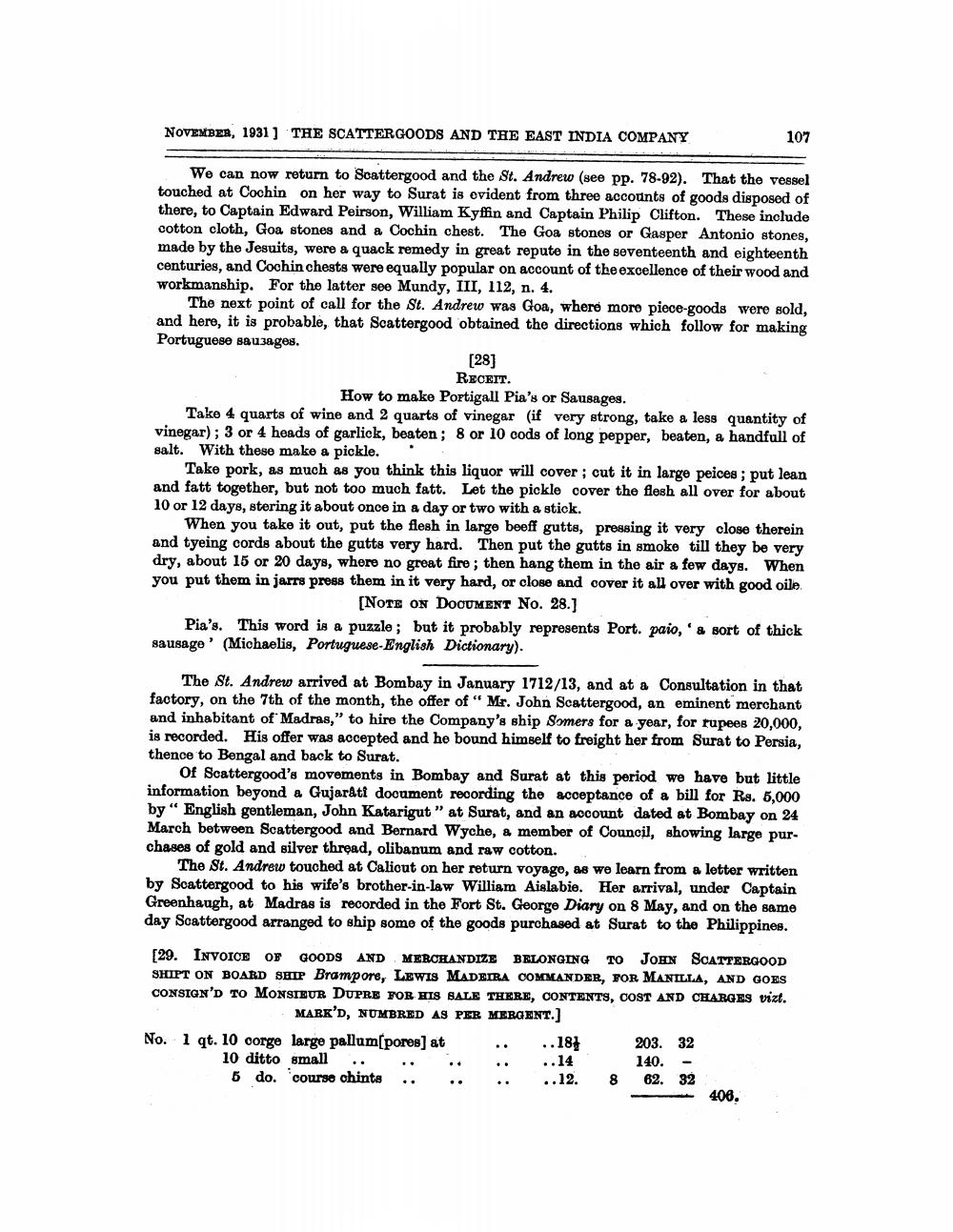________________
NOVEMBER, 1931 ] THE SCATTERGOODS AND THE EAST INDIA COMPANY
107
We can now return to Scattergood and the St. Andrew (see pp. 78-92). That the vessel touched at Cochin on her way to Surat is evident from three accounts of goods disposed of there, to Captain Edward Peirson, William Kyffin and Captain Philip Clifton. These include cotton cloth, Goa stones and a Cochin chest. The Goa stones or Gasper Antonio stones, made by the Jesuits, were a quack remedy in great repute in the seventeenth and eighteenth centuries, and Cochin chests were equally popular on account of the excellence of their wood and workmanship. For the latter see Mundy, III, 112, n. 4.
The next point of call for the St. Andrew was Goa, where moro piece-goods were sold, and here, it is probable, that Scattergood obtained the directions which follow for making Portuguese sausages.
[28]
RECEIT.
How to make Portigall Pia's or Sausages. Take 4 quarts of wine and 2 quarts of vinegar (if very strong, take a less quantity of vinegar); 3 or 4 heads of garlick, beaten; 8 or 10 cods of long pepper, beaten, a handfull of salt. With these make a pickle.
Take pork, as much as you think this liquor will cover ; cut it in large peices : put lean and fatt together, but not too much fatt. Let the pickle cover the flesh all over for about 10 or 12 days, stering it about once in a day or two with a stick.
When you take it out, put the flesh in large boeff gutts, pressing it very close therein and tyeing cords about the gutts very hard. Then put the gutts in smoke till they be very dry, about 15 or 20 days, where no great fire; then hang them in the air a few days. When you put them in jarrs press them in it very hard, or close and cover it all over with good oile.
[NOTE ON DOCUMENT No. 28.] Pia's. This word is a puzzle ; but it probably represents Port. paio, a sort of thick sausage' (Michaelis, Portuguese-English Dictionary).
The St. Andrew arrived at Bombay in January 1712/13, and at a Consultation in that factory, on the 7th of the month, the offer of " Mr. John Scattergood, an eminent merchant and inhabitant of Madras," to hire the Company's ship Somers for a year, for rupees 20,000, is recorded. His offer was accepted and he bound himself to freight her from Surat to Persia, thence to Bengal and back to Surat.
Of Scattergood's movements in Bombay and Surat at this period we have but little information beyond a Gujarati document recording the acceptance of a bill for Rs. 5,000 by" English gentleman, John Katarigut" at Surat, and an account dated at Bombay on 24 March between Scattergood and Bernard Wyche, & member of Council, showing large purchases of gold and silver thread, olibanum and raw cotton.
The St. Andrew touched at Calicut on her return voyage, as we learn from a letter written by Scattergood to his wife's brother-in-law William Aislabie. Her arrival, under Captain Greenhaugh, at Madras is recorded in the Fort St. George Diary on 8 May, and on the same day Scattergood arranged to ship some of the goods purchased at Surat to the Philippines.
[29. INVOICE OF GOODS AND MERCHANDIZE BELONGING TO JOIN SCATTERGOOD SHIPT ON BOARD SHIP Brampore, LEWIS MADEIRA COMMANDER, FOR MANILLA, AND GOES CONSIGN'D TO MONSIEUR DUPRE FOR HIS BALE THERE, CONTENTS, COST AND CHARGES vizt.
MARK'D, NUMBRED AS PER MERCENT.) No. 1 qt. 10 oorge large pallum(pores) at
..181 203. 32 10 ditto small .. .. .. ..
..14
140. - 5 do. 'course chints .. .. .. .. 12. 8 62.32
406.




